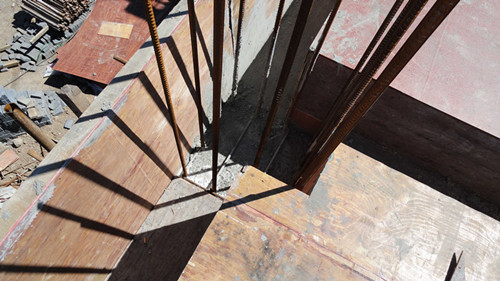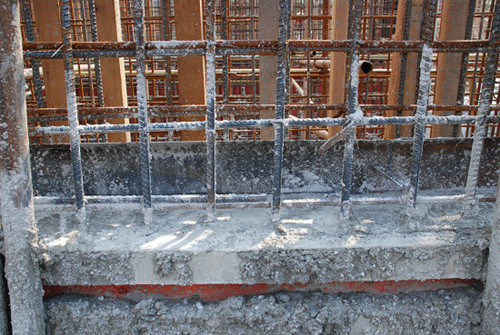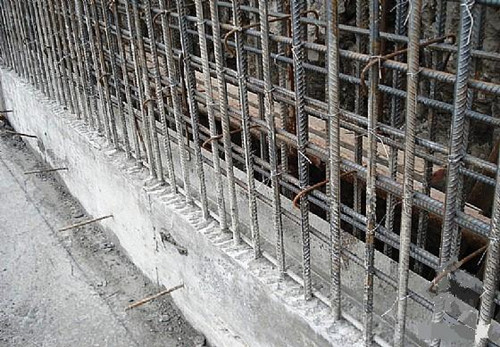The construction joint is not a real "slit", it is just because the post-cast concrete exceeds the initial setting time, and there is a joint surface with the concrete that is poured first. The joint surface is called a construction joint. This seam is not what the design needs at all. The following small series introduces construction joint processing methods and construction cracks for everyone. Construction joint treatment method 1. Be sure to clean the surface of the joint before pouring new concrete, such as loose sand. 2. The bare surface rust in the concrete should also be cleaned. 3, when necessary, the appropriate concrete can be cut hair. 4. Always flush the surface of the concrete with clean water to keep it moist before pouring new concrete. 5. Before pouring new concrete, a layer of cement mortar of 1 to 1.5 centimeters in thickness shall also be laid on the surface of the joint. If it is a horizontal seam, then 2 to 3 centimeters of cement mortar should be laid. 6. Be sure to consolidate the construction joints and nearby concrete. Causes of construction cracks 1, the temperature effect cracks In the shape of temperature cracks, oblique cracks are common, with a middle width, fine ends, or one end that is thin and the other end wide; then horizontally developed temperature cracks, which appear to be wide at both ends, in the middle, and broken. Continued development. Due to the change of the external environment temperature, different building materials and different parts of the building will have different deformations under the effect of temperature, and the deformation process will be constrained by the outside world, which will cause temperature cracks. 2. Shrinkage caused by cracks As a result of shrinkage, concrete undergoes tensile stress in the interior. When the tensile stress exceeds the tensile strength of the concrete, cracks will occur. The degree of slump of concrete has a certain influence on the occurrence of cracks. In the case of concrete with a large degree of slump, mortar layers and cement laitance layers will appear during the construction vibrating process. The two layers contain more The cement has relatively strong shrinkage properties; when the concrete sets and hardens, a large amount of water will evaporate into the air, causing a sharp shrinkage of the concrete volume. Because the early tensile strength of the concrete cannot resist the deformation, the concrete cracks are generated. 3, cracks caused by sedimentation In the masonry house structure, due to the uneven settlement of the foundation, settlement cracks appear in the structurally stressed parts. If there is a sudden change in the bearing capacity of the foundation of the building, the settlement cracks may also develop below the building. In severe cases, the entire building may be covered. Such cracks are mainly caused by improper construction methods or design mistakes; if the building uses pile foundations, when the pile foundation relies on the static load test to test the bearing capacity of the foundation, there are many factors affecting the pile foundation construction and the number of detections. Limited, it is difficult to ensure the accuracy of the test data, affect the design and construction of the pile foundation, and then lead to cracks due to the settlement of the foundation. 4, cracks in the construction process In the process of building construction, construction cracks are prone to occur due to improper construction techniques and operation methods, and there is no regularity in the distribution of such cracks. Caused by the cracks are due to: improper pipe settings, concrete strength does not meet the requirements, floor thickness is not enough, concrete curing conditions are poor, concrete pouring method and sequence is not right, pouring speed is too fast, premature demolition of concrete formwork, construction joints are not properly Treatments, construction joints are unreasonably set, steel reinforcement layers are too large, deformation of the reinforcement before pouring is too large, and lack of effective management at the construction site. Construction joint indwelling position 1. Construction joints shall be placed under the top of the foundation, below the girder or crane girder leg, above the crane girder, below the column caps of the beamless floor. 2. Join the slab with the large cross-section beam as a whole, and the construction joints should be placed 20mm to 30mm below the floor of the slab. When there is a beam under the board, stay in the lower part of the bracket. 3. For unidirectional plates with an aspect ratio of more than two to one, the construction joints shall be left in any position parallel to the short sides of the plates. At the same time, the construction joints shall be vertically indefinite, and they shall not be made inclining. 4. The slab with primary and secondary beam should be poured along the direction of the secondary beam. Construction joints should be placed within the middle 1/3 of the secondary beam span. 5. The construction joints on the wall shall be left in the middle 1/3 of the crossing span of the door opening, and may also be left at the intersection of the vertical and horizontal walls. 6. The construction joints on the stairs should stay at 1/3 of the tread board. The concrete of the stairs should be poured continuously. If it is a multi-story staircase and the upper floor is cast-in-place floor slab and not poured, the construction joint can be left; it should be left at 1/3 of the middle of the stair section, but it should be noted that the joint surface should be perpendicular to the axis of the stairs. direction. (The reason for the dispute in construction is that the old code stipulates that the stair construction joints must be placed in the middle 1/3 section, and the traditional construction is left at the upper and lower 3 steps, and when it is placed in the middle of the ladder section, the shear force is theoretically smaller. However, the quality of the construction joints during construction is not well controlled, and it is easy to produce a short-time “overhang†at the time of the secondary formwork, which is not conducive to the quality control of the components. 7. The construction joints of pool walls should be left on the vertical walls 200mm to 500mm above the floor surface. Editor's summary: The construction joint treatment method and the causes of construction cracks are introduced here. I hope to be helpful to everyone. If you want to know more about yourself, you can follow the information on this site. Curtain Installation Method Decoration Construction Knowledge Construction Bottom Installation Installation Contract Construction Joint Treatment Method Square Shower Drain,Shower Grates Drain,Square Gold Shower Floor Drain,Square Gold Floor Drain Kaiping City Jinqiang Hardware Products Co.,Ltd , https://www.jmkimpowerdrain.com

